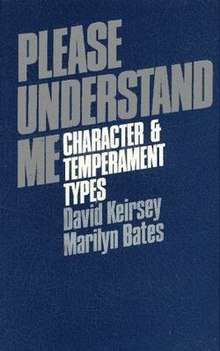Please Understand Me
 | |
| Author |
David Keirsey and Marilyn Bates |
|---|---|
| Country | United States |
| Language | English |
| Subject | Temperament, psychology, personality |
| Publisher | Prometheus Nemesis Book Company |
Publication date | 1984 |
| Media type | Paperback |
| Pages | 210 |
| ISBN | 0-9606954-0-0 |
| OCLC | 11585453 |
| Followed by | Please Understand Me II: Temperament, Character, Intelligence |
Please Understand Me: Character and Temperament Types is a psychology book written by David Keirsey and Marilyn Bates which focuses on the classification and categorization of personality types. The book contains a self-assessed personality questionnaire, known as the Keirsey Temperament Sorter, which links human behavioral patterns to four temperaments and sixteen character types. Once the reader's personality type has been ascertained, there are detailed profiles which describe the characteristics of that type.
Based upon the notion that peoples' values differ fundamentally from one another, Keirsey drew upon the views of several psychologists or psychiatrists: Ernst Kretschmer, Erich Adickes, Alfred Adler, Carl Jung and Isabel Myers who are all mentioned as predecessors in the psychology of temperament or personality.[1] Of these methods, preference is given to the Myers–Briggs test when determining personality type.[2]
Sixteen personality types
Keirsey and Bates offer a personality inventory to help readers identify their type. They are taken from the Myers-Briggs Personality Inventory. The sets of indicated preferences create sixteen types:
- I or E (Introversion–versus–Extroversion)
- N or S (INtuitive–versus–Sensing)
- T or F (Thinking–versus–Feeling)
- P or J (Perceptive–versus–Judging)
An appendix offers a concise profile for each of the sixteen types.[3]
Four temperaments
Then Keirsey simplifies these sixteen types into four groups, whose archetypes he equates with the classical four temperaments: NT (Rational), NF (Idealist), SP (Artisan), and SJ (Guardian).
- NT (INTJ, ENTP, INTP, ENTJ): Called the Promethean or Rational temperament
- NF (INFJ, ENFP, INFP, ENFJ): Called the Apollonian or Idealist temperament
- SP (ISTP, ISFP, ESTP, ESFP): Called the Dionysian or Artisan temperament
- SJ (ISTJ, ISFJ, ESTJ, ESFJ): Called the Epimethean or Guardian temperament
Keirsey organizes the groups asymmetrically, asserting Thinking–versus–Feeling as the most salient distinction among intuitives, but Perception–versus–Judging as the most salient distinction among Sensers. His methodology emphasizes the four temperaments, as he defines them, to generalize about different aptitudes and needs.
Please Understand Me II (1998) is a sequel, whose methodology generalizes more so according to these four categories.
References
- ↑ Keirsey & Bates (1984), pp. 3-4
- ↑ Keirsey & Bates (1984), p. 4
- ↑ http://www.myersbriggs.org/my-mbti-personality-type/mbti-basics/
Bibliography
- Keirsey, David; Bates, Marilyn (1984). Please Understand Me: Character & Temperament Types (Fifth ed.). Prometheus Nemesis Book Company. p. 182. ISBN 0-9606954-0-0.